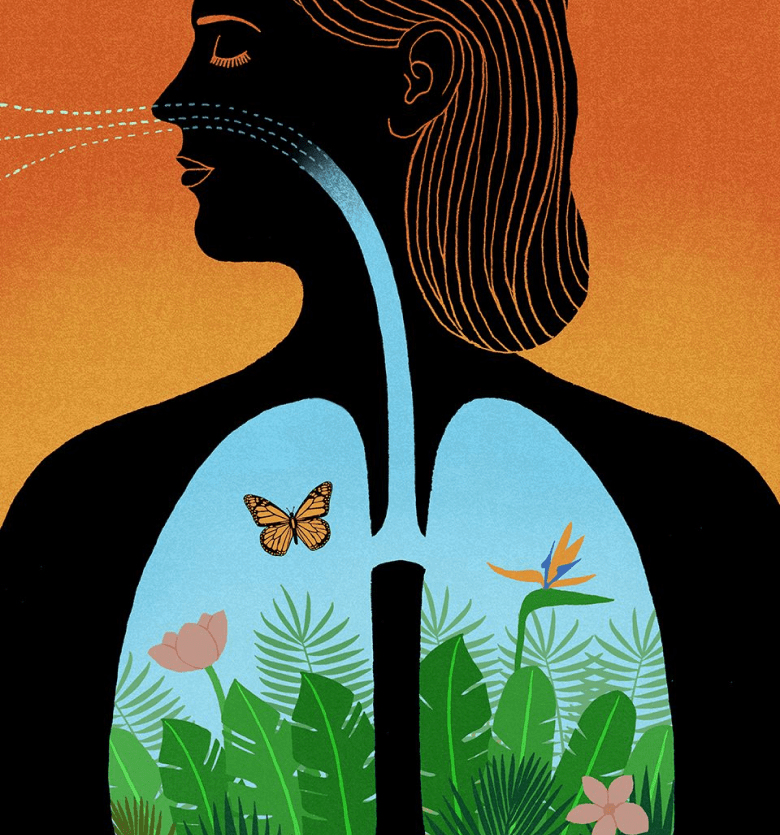First, let’s start with a little exercise:
Slowly inhale air through your nose and into your belly to the count of five. Now, without pausing, slowly exhale through the nose to the count of five. Repeat three more times.
Congratulations, you just completed a controlled breathing exercise.
You’re probably thinking “What’s the big deal? I breathe like 20,000 times a day.”
The difference is that those 20,000+ breaths we take every day are unconscious, or uncontrolled, meaning we don’t really think about them; they just happen.
Most of the time, our unconscious breaths are shallow and fast-paced. This can lead to stress, anxiety, and other health concerns.
The best way to combat this is to practice controlled breathing.
Deep, Slow, and Rhythmic
When we practice controlled breathing methods, like the one above, we invoke something called the relaxation response.
If you never consciously change your breathing patterns, adding a quick breathing practice to your daily routine can have profound effects.
“I have seen patients transformed by adopting regular breathing practices,” says Dr. Richard Brown, professor of psychiatry at Columbia University and co-author of The Healing Power of the Breath.
Deep, slow, rhythmic breaths send a message to the brain that all is well. This activates the parasympathetic nervous system, which promotes feelings of peace, calm, and sleepiness.
Essentially, when you practice a controlled breathing technique, you are hacking the brain/body connection, slowing the heart rate, easing anxiety, and reducing stress.
But Wait, There’s More
Controlled breathing exercises aren’t just for relaxation.
As more and more scientific studies come out, we are beginning to see that certain breathing techniques have the potential to improve other parts of our lives as well.
One study found a direct link between nasal breathing and improved cognitive function.
Another study shows that specific breathing patterns can lower your heart rate, blood pressure, and the levels of cortisol (the stress hormone) in your body.
There is some evidence that suggests these exercises can also boost the immune system.
“Breathing is essential for regulating the lymphatic system – the network of tissues and organs in your body that help to detoxify the body by transporting lymph, a fluid that contains powerful infection-fighting white blood cells, throughout the body,” says Primal Health coach Charlene Gisele.
Finally, a famous study published in 2001 showed that a slow, controlled breathing pattern allowed the systems of the body to enter a state of coherence. Functions of the heart, circulation, and nervous system all coordinated to peak efficiency.
This breathing pattern, about 5.5 breaths per minute, just so happens to be the breath pace of people reciting prayers.
It turns out that Buddhist mantras, the Latin version of the rosary, the Catholic’s Ava Marie, Hindu, Taoist, and Native American prayers all have almost an identical breathing pattern associated with them; 5.5 breaths per minute.
“We believe that the rosary may have partly evolved because it synchronized with the inherent cardiovascular rhythms, and thus gave a feeling of wellbeing,” the researchers write.
As breathing researcher James Nestor writes in his book Breath, “Prayer heals, especially when it’s practiced at 5.5 breaths per minute.”
Still Learning, Still Practicing
As a society, we still have a lot to learn about the effects and mechanisms of breathing, which is pretty funny considering it’s the one thing that all of us do the most.
But, one thing is for certain; controlled breathing techniques are a safe, accessible way to improve our overall wellbeing.
There are dozens of controlled breathing techniques that have proven benefits, from box breathing to the 4-7-8 method.
Today, we recommend trying the “Perfect Breath” exercise, modeled after the fascinating prayer study above.


